TPROduction/iStock via Getty Images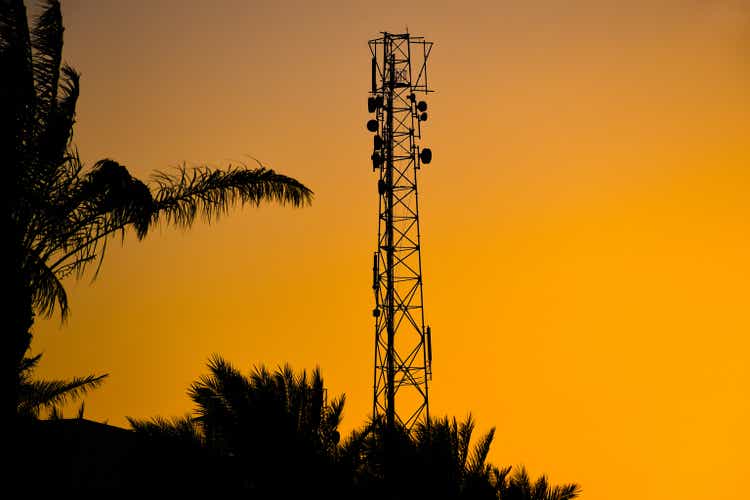
Introduction
Airtel Africa is a telecommunication and fintech company based in Africa. Airtel Africa operates 14 mobile networks in Africa, with Nigeria being their largest market. Airtel also operates the Airtel Money platform, which provides online mobile payment and banking services to 26.2M users. Africa is a continent with immense opportunity. Both business segments that Airtel Africa operates in are benefiting from large tailwinds such as increasing mobile penetration, data usage, and mobile banking use. All three areas are lagging behind other emerging markets like Asia and Latin America, and so have a lot of “catch up” opportunities. This gives Airtel a long growth runway, not to mention Airtel is trading at under 12 times FCF with a rising ROIC of over 20%.
Opportunity in Africa
The opportunity in Africa is characterized by increasing mobile penetration, data usage, and a large unbanked population.
Mobile Penetration
Airtel’s largest markets are Nigeria, DRC, and Kenya, and in these markets, mobile penetration is 92%, 118%, and 51%, respectively. Mobile penetration is calculated as the number of sim cards in use. However, this is a misleading metric as most consumers in Africa use multiple sim cards, so they can switch among network providers easily. If you look at unique mobile penetration which adjusts for multiple sim cards, sub-Saharan Africa, which emphasizes most of Airtel’s 14 markets, stands at around 50%. Airtel’s largest markets Nigeria, DRC, and Kenya have unique mobile penetration of 47%, 43%, and 61%.
Airtel Africa’s Top Six Markets (Source: Airtel Africa’s 2022 Annual Report)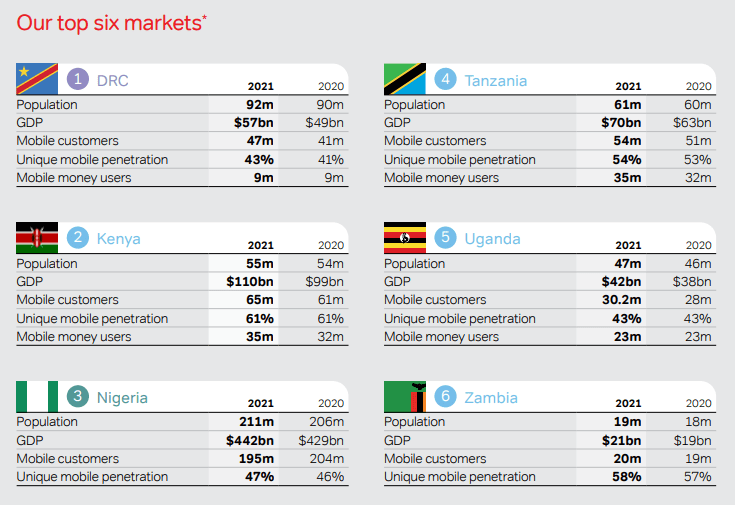
This is quite low and represents a vast opportunity for Airtel to participate. For example, Latin America at the end of 2020 had 70% unique mobile penetration. Not only is the mobile penetration low, but it’s growing fast if we look at just Airtel’s top 6 markets total mobile customers increased by 71m in 4 years which is a 20% increase. This is much faster growth than anywhere in the world. Airtel themselves has grown customers from 89m in 2017 to 128m in 2022.
|
Country |
Mobile Customers 2022 |
Mobile Customers 2018 |
|
Nigeria |
195m |
172m |
|
Kenya |
65m |
50m |
|
DRC |
47m |
36m |
|
Uganda |
30m |
23m |
|
Zambia |
20m |
15m |
|
Tanzania |
54m |
44m |
|
Total |
411m |
340m |
Source: Author created table data from Airtel Africa’s annual reports
Not only is there a massive amount of customers left to acquire, but Africa has the fastest growing population. Africa’s population is projected to grow at 2.5% compared to other emerging markets like Latin America and Asia where growth is only .8% and .7%.
Source: Airtel Africa FY22 Presentation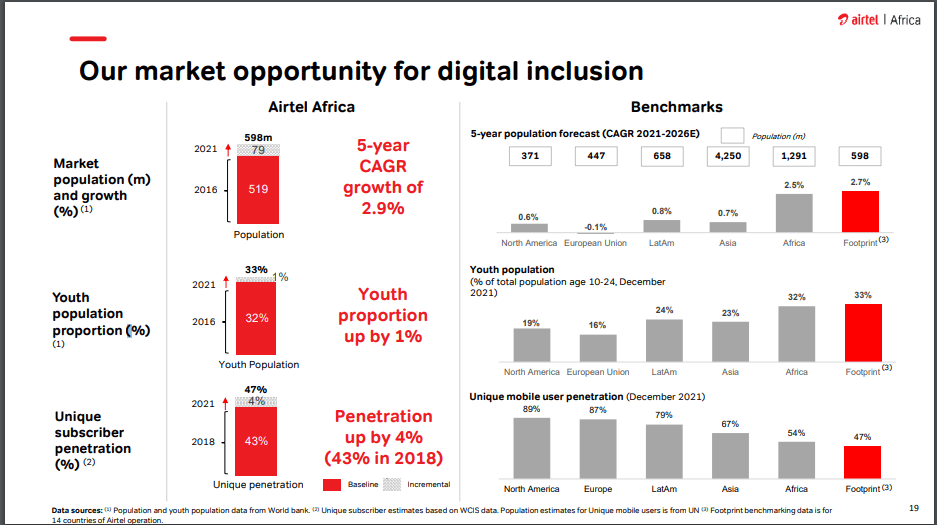
Data Usage
Data usage is an even bigger opportunity than mobile penetration. The average Sub-Saharan African smartphone user only uses 2.9GB of data per month. This is the lowest amount of data usage in the world, with Latin America being 3 times higher. By 2027 data usage in Sub-Saharan Africa is forecasted to be 11GB per month, which is a 25% CAGR.
Source: Ericsson Mobile Data Traffic Report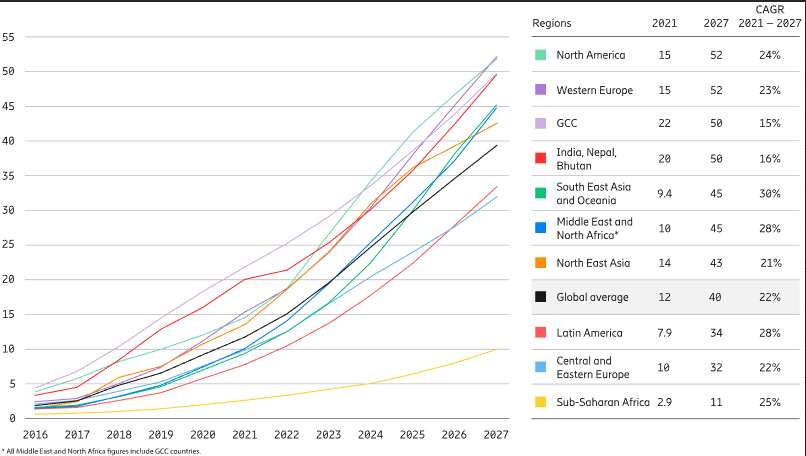
Not only is data usage low and growing, the total amount of customers using data is dramatically lower than customers using voice service. Airtel has a total of 128m customers using their mobile services as of their 2022 annual report, but only 46.7m are using data services. The number of people using data correlates to smartphone penetration. Currently, Airtel’s markets only have a 39% Smartphone penetration. Brazil for example has 76% smartphone penetration. The growth in data usage and data customers will be massive. Already data growth per customer for Airtel has grown from less than 1 GB in 2018 to 3.52 GB in 2022.
|
Year |
2022 |
2021 |
2020 |
2019 |
2018 |
|
Data Usage per Customer |
3.52GB |
2.67GB |
1.86GB |
1.19GB |
.95GB |
Source: Table created by author data collected from company annual reports
Mobile Money/Fintech
The last growth area is the Mobile Money segment. Many people in Africa lack basic banking services. According to the EIB, less than half of adults in Africa have a bank account. This is where mobile money comes in. Mobile money allows you to do everything a bank does such as send and receives payments, checking and saving services, and loans. By the end of 2021 50% of the Sub-Saharan African population or 621m were using mobile money services. Growth is driven by smartphone penetration and network coverage growth. Airtel has seen fast customer growth through its Airtel Money platform. Airtel money has grown customers for their platform from 11m to 26m since 2018.
|
Year |
2022 |
2021 |
2020 |
2019 |
2018 |
|
Customer Growth |
26.2m |
21.7m |
18.3m |
14m |
11m |
Source: Table created by author data collected from company annual reports
Airtel Africa’s growth opportunity in data usage, mobile penetration, and mobile money is massive. Next, I’ll look more specifically at Airtel’s Financials, strategy, and execution.
Financials
Since Airtel’s IPO in 2019 Airtel has been growing revenue, expanding margins, and increasing ROIC. Airtel pairs this growth with a cheap valuation. Airtel’s prize is its fintech platform, which could be worth close to half its market cap.
Financial Performance
Airtel has been executing on its growth potential. Revenue Growth has averaged 13% over the past 4 years. ROIC, a measure of management efficiency, has increased from 12% to 23% in the most recent year. Both FCF margin and EBITDA margin have increased dramatically since 2019. The FCF margin of 14% in the most recent year is especially impressive due to a corporate tax rate of 39%.
|
Year |
Average |
2022 |
2021 |
2020 |
2019 |
|
Revenue Growth |
13.43% |
20% |
14% |
10.8% |
8.4% |
|
FCF Margin |
9% |
14.08% |
12.09% |
9.16% |
.58% |
|
ROIC |
16.35% |
23.3% |
16.5% |
13.5% |
12% |
|
EBITDA |
46% |
49% |
46.1% |
44.3% |
43.3% |
Source: Table created by author data collected from company annual reports
Fintech
Airtel Money is the third-largest mobile money platform in Africa with 26.2m customers. Airtel as of Q1 2023 has obtained a mobile money license to operate in Nigeria which is the largest country in Africa with 220m people. This will be an enormous expansion for Airtel money where they could easily double customers in a short time period.
|
Mobile Money Customers by Company |
|
|
Company |
Customer Base |
|
Vodacom M-Pesa (OTCPK:VDMCY) |
60.6m |
|
MTN Money (OTCPK:MTNOY) |
56.8m |
|
Airtel Money |
26.2m |
|
Orange Money (ORAN) |
25.1m |
|
Wave |
10m |
Source: Table created by author data collected from company annual reports
The mobile money platform that Airtel has built is worth quite a lot. Mastercard recently invested in Airtel Money back in 2020 at a 12 times EBITDA multiple. Airtel intends to spin off this valuable asset to monetize it within 3 years. Using the multiple that Mastercard invested at, Airtel Money is worth 3.2 Billion Dollars. Airtel has sold a minority stake not only to Mastercard but TPG and two other investors. I estimate the total minority stake to be around 20% of the company. Airtel is currently valued at 5.4B pounds once you net out Airtel Money, the remainder of the company is only trading at 1.9 times EBITDA or 4.75 times EV/EBITDA. This comes out to a less than 7 times FCF multiple. Including Airtel Money in the operation, Airtel is trading at 12 times FCF multiple. This is extremely cheap for a company with the return on capital and growth prospects that Airtel has.
|
Multiples (Currency in USD) |
|
|
Airtel Money Valuation x Minority Stakes |
$2.6B |
|
Airtel Market Cap |
$6.4B |
|
Airtel Market Cap x Airtel Money |
$3.8B |
|
EBITDA x Airtel Money |
$2B |
|
EBITDA Multiple x Airtel Money |
1.9 |
|
EV/EBITDA x Airtel Money |
4.75 |
|
Current FCF to controlling shareholders |
$541m |
|
Current FCF Multiple |
12 |
Source: Table created by author data collected from company annual reports
Risks
I see two main risks to Airtel, this includes political instability, competition, and debt.
Political Instability
Africa is not known for the most stable governments. For example, Ethiopia is currently in a civil war and in Nigeria 800 inmates were broken out of a prison. This general instability of African nations is the largest risk. Nigeria is Airtel’s largest market by revenue and thus the biggest country risk.
Competition
Competition in mobile services usually forms into an oligopoly structure. The real risk in competition comes from mobile money. The vast opportunity of unbanked individuals is attracting lots of fintech investment. Orange reported a large slowdown in mobile money revenues citing Wave, a VC-backed fintech platform as a key reason for the slowdown.
Debt
Airtel’s debt is mostly fixed which is good, however, most of the debt is in USD. Airtel derives its revenues in African currencies, which creates a mismatch for their liabilities. A large devaluation in African currencies could negatively affect Airtel’s ability to pay its debt.
Source: Airtel’s 2022 Annual Report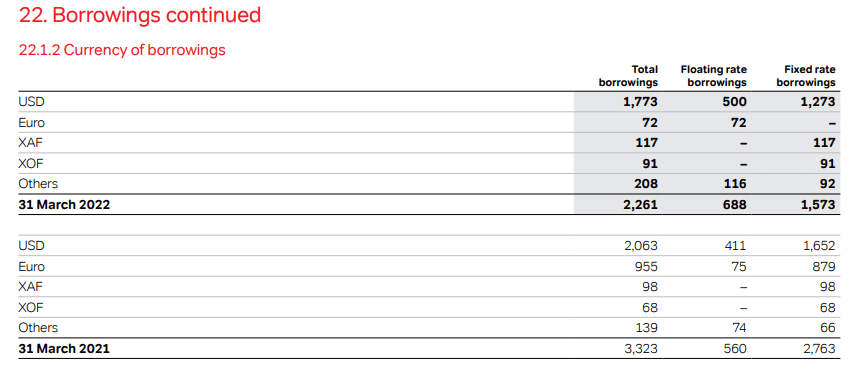
In Airtel’s Q1 2023 call, management announced they intend to change their debt structure with more local currency debt in the operating companies rather than foreign currency debt at the holding company level.
Conclusion
Airtel Africa is benefiting from large tailwinds as smartphone penetration, data usage and banking services are growing fast in Africa. This gives Airtel a long growth runway. Not to mention, Airtel has been executing by growing their revenue, expanding margins and increasing ROIC – with ROIC of over 20%. Mobile money is an especially valuable segment that Airtel will be monetizing soon. All this at only 12 times FCF.
Side Note:
Airtel Africa’s listing in the UK ticker (AAF) is a lot more liquid than Airtel’s OTC listings in the US.


Be the first to comment